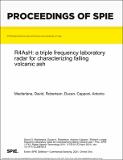Files in this item
R4AsH : a triple frequency laboratory radar for characterizing falling volcanic ash
Item metadata
| dc.contributor.author | Macfarlane, David Graham | |
| dc.contributor.author | Robertson, Duncan A. | |
| dc.contributor.author | Capponi, Antonio | |
| dc.contributor.editor | Ranney, Kenneth | |
| dc.contributor.editor | Raynal, Ann | |
| dc.date.accessioned | 2021-04-22T10:30:11Z | |
| dc.date.available | 2021-04-22T10:30:11Z | |
| dc.date.issued | 2021-04-12 | |
| dc.identifier | 273887378 | |
| dc.identifier | 99b965b3-5d82-4329-8922-64eb65846524 | |
| dc.identifier | 85107417448 | |
| dc.identifier | 000691546200025 | |
| dc.identifier.citation | Macfarlane , D G , Robertson , D A & Capponi , A 2021 , R4AsH : a triple frequency laboratory radar for characterizing falling volcanic ash . in K Ranney & A Raynal (eds) , Radar Sensor Technology XXV . Proceedings of SPIE , vol. 11742 , SPIE , SPIE Defense + Commercial Sensing , 12/04/21 . https://doi.org/10.1117/12.2587613 | en |
| dc.identifier.citation | conference | en |
| dc.identifier.issn | 0277-786X | |
| dc.identifier.other | ORCID: /0000-0002-4042-2772/work/92775857 | |
| dc.identifier.uri | https://hdl.handle.net/10023/23074 | |
| dc.description.abstract | Airborne ash generated by explosive volcanic eruptions presents a significant danger to aviation. Accurate modelling and predictions of the dispersal of hazardous ash into the atmosphere are currently hampered by uncertainties in the ‘source term’ parameters associated with the initial eruption plume, specifically the amount and size of ash particles released into the atmosphere. Ground based radar offers the means to remotely measure ash reflectivity, however estimation of source term parameters from reflectivity measured by single frequency radar is limited by ambiguity between the contribution of particle size distribution (PSD) and ash concentration in the plume. This means that one of these parameters must be assumed rather than measured directly, leading to uncertainties in forecasting eruption hazards. We report on R4AsH, a close range FMCW radar designed to resolve this ambiguity by simultaneous characterization of falling volcanic ash in a laboratory-controlled environment at three different frequencies: 10, 35 and 94 GHz. The R4AsH design uses a single DDS based chirp generator as a common source, multiplied and upconverted to feed three sets of transmit-receive horn antennas directed at a common target volume such that measurements will give spatially and temporally coincident measurements of falling ash. In addition, there will be independent measurement of the PSD using optical imaging and logging of the landing particle mass to calibrate results and inform analysis. The aim of R4AsH is to develop a triplefrequency inversion algorithm to enable simultaneous retrieval of PSD and ash concentration from radar data suitable for future volcano monitoring systems. | |
| dc.format.extent | 8 | |
| dc.format.extent | 1172153 | |
| dc.language.iso | eng | |
| dc.publisher | SPIE | |
| dc.relation.ispartof | Radar Sensor Technology XXV | en |
| dc.relation.ispartofseries | Proceedings of SPIE | en |
| dc.subject | Volcanic ash | en |
| dc.subject | FMCW radar | en |
| dc.subject | Radar cross section | en |
| dc.subject | Reflectivity | en |
| dc.subject | Horn antenna | en |
| dc.subject | Multi-frequency | en |
| dc.subject | QC Physics | en |
| dc.subject | T Technology | en |
| dc.subject | NS | en |
| dc.subject.lcc | QC | en |
| dc.subject.lcc | T | en |
| dc.title | R4AsH : a triple frequency laboratory radar for characterizing falling volcanic ash | en |
| dc.type | Conference item | en |
| dc.contributor.institution | University of St Andrews. School of Physics and Astronomy | en |
| dc.identifier.doi | https://doi.org/10.1117/12.2587613 |
This item appears in the following Collection(s)
Items in the St Andrews Research Repository are protected by copyright, with all rights reserved, unless otherwise indicated.

